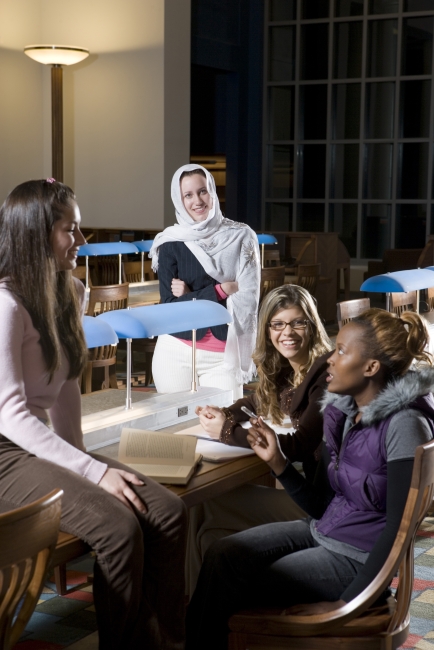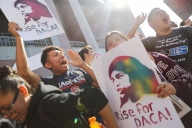You have /5 articles left.
Sign up for a free account or log in.

Getty Images
The vast majority of freshmen expect their colleges to provide a welcoming environment for people from diverse religious and nonreligious perspectives, according to findings from a new survey released this week. But those same students may not be so welcoming themselves.
Researchers from New York University and North Carolina State University joined with Interfaith Youth Core to conduct the national study at 122 institutions last year. The colleges were a mix of private and public colleges and universities, both religious and nonreligious (the former included Roman Catholic, mainline Protestant and evangelical colleges). More than 20,000 freshmen responded to the survey.
About 85 percent of the freshmen said that it is “important for their colleges to provide a welcoming environment for individuals of diverse religious backgrounds and nonreligious perspectives.” The students said religious diversity is as important as other forms of diversity, including gender identity, sexual orientation, race and ethnicity.
When students were asked about their own attitudes toward specific religious and nonreligious groups, however, the responses were not as aspirational. Just over half of the students surveyed said they had “highly appreciative attitudes” toward Buddhists, Jews and evangelical Christians. Less than half of students reported having highly appreciative attitudes toward atheists and Hindus.
About 43 percent said they had highly appreciative attitudes toward Muslims. Just 39 percent held favorable attitudes about Mormons.
The researchers gauged the students’ attitudes by asking them how much they agreed with four statements: "people in this group make positive contributions to society," "individuals in this group are ethical people," "I have things in common with people in this group" and "in general, I have a positive attitude toward people in this group."
Matthew Mayhew, an associate professor of higher education at New York University and one of the study’s principal investigators, called the findings “troubling.”
“Even though students are saying they expect real diversity and want a welcoming environment for everyone, the numbers don’t line up when you start drilling down into attitudes about specific groups,” Mayhew said. “The numbers are staggering.”
Even more concerning, the researchers said, is that the students are interacting with people of other faiths before coming to college at a much higher rate than in years past. That finding is encouraging, Mayhew said, but that these interactions are happening and students are coming away from those exchanges with negative attitudes about different groups is worrying.
“That could mean that these experiences are not being properly supported and that students are not learning what they should,” Mayhew said. "They're having these exchanges, but are still retreating into stereotypes for those groups. Once they're in college, we have to try and dismantle those."
The researchers also said that the disconnect between expectations, aspirations and personal attitudes may stem from how the survey, which was more detailed than most questionnaires of its kind, was written.
Questions about institutional support for religious diversity were vague, and did not mention any specific groups. When asked generally if they respect people of other perspectives, 91 percent of students said they did. Nearly 85 percent of students said they admired people of other faiths.
When answering those questions, the researchers said, students may think of diversity in more narrow terms. A Catholic student may consider supporting religious diversity as being welcoming to Protestants and evangelicals, for example, with her attitudes about specific groups like Muslims not factoring in until she is questioned more directly.
The study found that there was also a disconnect between students' interfaith aspirations and actions.
More than 70 percent of students placed importance on their colleges providing opportunities to “get to know” people from different religious and nonreligious perspectives, and 68 percent said it was important that their colleges provide opportunities to participate in community service with people from different faiths.
About 83 percent of respondents said that they agreed with the phrase “we can overcome many of the world’s major problems if people of different religious and nonreligious perspectives work together.”
At the same time, only half of the students said they had worked on service projects with people of different religious and nonreligious perspectives in the last 12 months. About one-third said they had attended a religious service other than their own, and fewer than 20 percent said they had participated in an interfaith dialogue.
A study released by the same researchers and the Interfaith Youth Core last year found that a lack of interfaith interaction is not limited to freshmen. That survey collected responses from 8,000 students from 38 public and private institutions between 2011 and 2014. Just 3 percent of students said they participate frequently in interfaith programming on campus.
The new study -- called the Interfaith Diversity Experiences and Attitudes Longitudinal Survey -- is designed to track the respondents’ attitudes and behaviors over the next four years. The researchers will check back in with the same cohort when they are sophomores and seniors.
“The findings so far show that there is a difference between students’ general beliefs and specific attitudes, and a difference between their aspirations and their behavior,” said Ben Correia, campus assessment manager at Interfaith Youth Core. “We’re going to be working to answer what’s behind that.”








